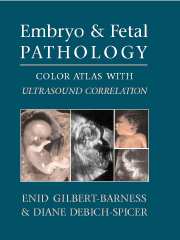Book contents
- Frontmatter
- Contents
- Foreword by John M. Opitz
- Preface
- Acknowledgments
- 1 The Human Embryo and Embryonic Growth Disorganization
- 2 Late Fetal Death, Stillbirth, and Neonatal Death
- 3 Fetal Autopsy
- 4 Ultrasound of Embryo and Fetus: General Principles
- 5 Abnormalities of Placenta
- 6 Chromosomal Abnormalities in the Embryo and Fetus
- 7 Terminology of Errors of Morphogenesis
- 8 Malformation Syndromes
- 9 Dysplasias
- 10 Disruptions and Amnion Rupture Sequence
- 11 Intrauterine Growth Retardation
- 12 Fetal Hydrops and Cystic Hygroma
- 13 Central Nervous System Defects
- 14 Craniofacial Defects
- 15 Skeletal Abnormalities
- 16 Cardiovascular System Defects
- 17 Respiratory System
- 18 Gastrointestinal Tract and Liver
- 19 Genito-Urinary System
- 20 Congenital Tumors
- 21 Fetal and Neonatal Skin Disorders
- 22 Intrauterine Infection
- 23 Multiple Gestations and Conjoined Twins
- 24 Metabolic Diseases
- Appendices
- Index
17 - Respiratory System
Published online by Cambridge University Press: 23 February 2010
- Frontmatter
- Contents
- Foreword by John M. Opitz
- Preface
- Acknowledgments
- 1 The Human Embryo and Embryonic Growth Disorganization
- 2 Late Fetal Death, Stillbirth, and Neonatal Death
- 3 Fetal Autopsy
- 4 Ultrasound of Embryo and Fetus: General Principles
- 5 Abnormalities of Placenta
- 6 Chromosomal Abnormalities in the Embryo and Fetus
- 7 Terminology of Errors of Morphogenesis
- 8 Malformation Syndromes
- 9 Dysplasias
- 10 Disruptions and Amnion Rupture Sequence
- 11 Intrauterine Growth Retardation
- 12 Fetal Hydrops and Cystic Hygroma
- 13 Central Nervous System Defects
- 14 Craniofacial Defects
- 15 Skeletal Abnormalities
- 16 Cardiovascular System Defects
- 17 Respiratory System
- 18 Gastrointestinal Tract and Liver
- 19 Genito-Urinary System
- 20 Congenital Tumors
- 21 Fetal and Neonatal Skin Disorders
- 22 Intrauterine Infection
- 23 Multiple Gestations and Conjoined Twins
- 24 Metabolic Diseases
- Appendices
- Index
Summary
LUNG MATURITY
Amniotic fluid can be tested for phospholipid components of fetal lung surfactant.
The lecithin-to-sphingomyelin (L/S) ratio is the most widely used index. An L/S of >2.0 indicates fetal lung maturity in most cases. An L/S of <2 does not reliably exclude lung maturity.
The presence of phosphatidylglycerol (PG), a late-appearing surfactant component, has greater positive predictive value than the L/S ratio in determining fetal lung maturity. However, PG has lower sensitivity. A positive PG is helpful when the L/S is marginal.
RESPIRATORY TRACT ABNORMALITIES Choanal atresia
Choanal atresia is the failure of communication between the posterior nasal sacs and the oral cavity.
Laryngeal stenosis is a narrowing of the laryngeal cavity (Figure 17.1).
Laryngeal cleft is incomplete formation of the larynx (Figure 17.2).
Tracheoesophageal Fistula
The incidence of tracheoesophageal fistula (TEF) with or without esophageal atresia is 1/1,000 to 1/2,500 births (Figures 17.3 and 17.4 and Table 17.1). TEF is rarely familial and there are at least six anatomic types. More than 85% of all cases are of type 1 esophageal atresiawith fistula fromthe trachea or carina to the lower esophageal segment. Type 2 – esophageal atresia with TEF – is the next most common. The other types are shown in Figure 17.1.
- Type
- Chapter
- Information
- Embryo and Fetal PathologyColor Atlas with Ultrasound Correlation, pp. 470 - 489Publisher: Cambridge University PressPrint publication year: 2004
- 1
- Cited by

